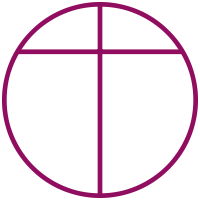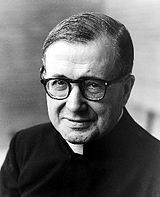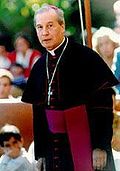- Priestly Society of the Holy Cross
-
The Priestly Society of the Holy Cross is an association of clergy within the Roman Catholic Church "intrinsically united" to Opus Dei.
According to the Annuario Pontificio, there were 1996 priests of the Prelature in the year 2009. In 2005, there were roughly two thousand diocesan priests who belonged to society who were not clergy of the prelature, thus the total membership of the society is around 4000 priests.
Contents
Foundation and mission
The Priestly Society of the Holy Cross was begun by St. Josemaría on 14 February 1943, and received its first canonical approval a few months later. He was always concerned that his message of sanctification of ordinary work be transmitted also to the secular clergy. He even said that he was willing to leave Opus Dei, as Abraham offered up his son Isaac, to be able to help the clergy. But on February 14 1943, he said he received an illumination from God on how to continue serving both the laity and the diocesan clergy.
During Mass at the women's center of Opus Dei, he was shown the seal of Opus Dei and of the Priestly Society of the Holy Cross: a cross embracing the world. He was also shown the juridical solution to put the two together. The priests would be part of a society united to Opus Dei, but the diocesan priests would continue to be priests of their dioceses, and thus there will be no conflict with the bishops.
The first priests of the Priestly Society were the numerary members of Opus Dei, who as such are automatically members of the Society. The first three priests ordained as members of the Society were: Álvaro del Portillo, José Luis Muzquiz and José María Hernández Garnica.
The need for this type of association has been explained in the following way:
- As many priests can testify, loneliness can be the most difficult Cross to embrace. However, there are remedies for loneliness, and priests are free to seek for that help upon which their happiness largely relies. Diocesan priests can certainly establish their own support groups for prayer, socializing, exercise, and relaxation. But normally that is not enough. In #29 of the DLMP, the document, echoing the Second Vatican Council (Prebyterorum ordinis, #8) and the Code of Canon Law (C 550, n. 2), highly praises “those associations which support priestly fraternity, sanctity in the exercise of their ministry, and communion with the Bishop and with the entire Church”. [1]
Establishment by Pope John Paul II
 John Paul II ordaining the first Bishop-prelate of Opus Dei, Álvaro del Portillo.
John Paul II ordaining the first Bishop-prelate of Opus Dei, Álvaro del Portillo.According to the Apostolic Constitution Ut sit issued by John Paul II: “From its beginnings, this (Opus Dei) has in fact striven, not only to illuminate with new lights the mission of the laity in the Church and in society, but also to put it into practice; it has also endeavored to put into practice the teaching of the universal call to sanctity, and to promote at all levels of society the sanctification of ordinary work, and by means of ordinary work. Furthermore, through the Priestly Society of the Holy Cross, it has helped diocesan priests to live this teaching, in the exercise of their sacred ministry.”
Through this document, John Paul II, aside from erecting Opus Dei as a personal prelature, also erected the Priestly Society of the Holy Cross “as a priestly Association intrinsically united to the Prelature.” [2]
Composition
It is made up first of all of the clergy of the Prelature who are automatically members. Secondly, it is made up of diocesan priests, deacons, and bishops. Some Opus Dei members also serve as bishops in various dioceses throughout the world, including the United States, Europe, South America, and Africa. The prelate of Opus Dei is the president of the society.
These diocesan clergy of the Priestly Society are not incardinated into the presbyterate of the Prelature. They depend solely on their bishop and receive spiritual help from the Society to fulfill their priestly duties well.
According to the Annuario Pontificio, there were 1996 priests of the Prelature in the year 2009. John Allen stated there were roughly two thousand diocesan priests who belonged to society who were not clergy of the prelature, thus the total membership of the society is around 4000 priests.
Formation
The priests are given the same formation as the lay faithful of Opus Dei. St. Josemaría always said that he has “the same cooking pot” for his children: classes on doctrine, ascetical formation, spiritual direction, recollections, retreats, etc.
Membership
There are around 2000 priests, bishops and deacons around the world who are members of the Priestly Society of the Holy Cross.
Here are some of the prominent members of the Society:
Founder:
- Saint Josemaría Escrivá, founder of Opus Dei (d.1975)
Prelates of Opus Dei:
- Álvaro del Portillo y Diez de Solano, (d. 1994), Prelate of Opus Dei and Titular Bishop of Vita
- Javier Echevarria Rodriguez, Prelate of Opus Dei and Titular Bishop of Cilibia
Cardinals:
- Juan Luis Cipriani Thorne, Archbishop of Lima, former Archbishop of Ayacucho o Huamanga, Peru
- Julián Herranz Casado, President emeritus of the Pontifical Council for Legislative Texts
Bishops:
- Antonio Arregui Yarza, Archbishop of Guayaquil, Ecuador
- Luis Gleisner Wobbe, Titular Bishop of Mididi, Auxiliary Bishop of Rancagua, Auxiliary Bishop of La Serena, Chile
- Alfonso Delgado Evers, Bishop of San Juan de Cuyo, former Bishop of Santo Tomé, former Bishop of Posadas, Argentina
- Antonio Augusto Dias Duarte, Titular Bishop of Tuscamia, Auxiliary Bishop of São Sebastião do Rio de Janeiro
- Robert Finn, Bishop of Kansas City - Saint Joseph, Missouri
- John Barres, Bishop of Allentown, Pennsylvania
- Ricardo García García, Prelate of Yauyos, Peru
- Ignacio González Errazúriz, Bishop of San Bernardo, Chile
- Francisco de Guruceaga Iturriza, Bishop of Margarita, former Bishop of La Guaira, former Auxiliary Bishop of Ciudad Bolivar, Venezuela
- Ignacio María de Orbegozo y Goicoechea, Bishop of Chiclayo, and former Prelate of Yauyos, Peru
- José Horacio Gómez, S.T.D., Archbishop of Los Angeles, California; former Archbishop of San Antonio, Texas; and former auxiliary for the Archdiocese of Denver, Colorado, United States of America
- Philippe Jean-Charles Jourdan, Apostolic Administrator of Estonia
- Klaus Küng, Bishop of Sankt Pölten, former Bishop of Feldkirch, Austria
- Juan Ignacio Larrea Holguín, Archbishop of Guayaquil, former Bishop of Quito, former Military Ordinary, former Auxiliary Bishop of Quito, Ecuador
- Rogelio Ricardo Livieres Plano, Bishop of Ciudad del Este, Paraguay
- Rafael Llano Cifuentes, Bishop of Nova Friburgo, Rio de Janeiro, former auxiliary Bishop of Archdiocese of São Sebastião do Rio de Janeiro in Brazil
- Anthony Muheria, Bishop of Embu, Kenya
- Francisco Polti Santillan, Bishop of Santo Tome, Argentina
- Jaume Pujol Balcells, Archbishop of Tarragona, Spain
- Ugo Eugenio Puccini Banfi, Bishop of Santa Marta, and former Auxiliary Bishop of Barranquilla, Colombia
- Luis Sánchez-Moreno Lira, Archbishop of Arequipa, former Prelate of Yauyos, Peru
- Fernando Saenz Lacalle, Archbishop of San Salvador, former Apostolic Administrator of the Military of San Salvador
- Juan Antonio Ugarte Perez, Archbishop of Cuzco, former Auxiliary Bishop of Abancay, and former Auxiliary Bishop of Yauyos, Peru
- Adolfo Rodríguez Vidal Bishop Emeritus of Los Angeles, Chile
Basic references
- Pope John Paul II. Apostolic Constitution Ut Sit Establishing the Personal Prelature of Opus Dei and the Vatican Declaration on Opus Dei
- Pope John Paul II. Christifideles Omnes, Papal Decree on Escriva's Heroic Virtues
- Cardinal José Saraiva Martins, St. Josemaría: God's Instrument for Opus Dei - statement of the Prefect of the Congregation for the Causes of Saints on St. Josemaría and Opus Dei's message of sanctity
- Escrivá, Josemaría. The Way, Furrow, The Forge, Christ is Passing By, Friends of God, Loyalty to the Church, Conversations with Msgr. Josemaría Escrivá, Scepter Publishers -- the founder's teachings and explanations about Opus Dei; the most basic reference
- Müller, Beat. Opus Dei Information Handbook -- a basic text given to journalists
- Shaw, Russel (1994). Ordinary Christians in the World --- from the Office of Communications, Prelature of Opus Dei in the US
- Belda, M.; Escudero J.; Illanes, J.L.; & O'Callaghan, P. (Eds.) (1997). Holiness and the World: Studies in the Teachings of Blessed Josemaría Escrivá. Scepter Publications.-- collection of contributions to a theological symposium; contributors include Ratzinger, del Portillo, Cottier, dalla Torre, Ocariz, Illanes, Aranda, Burggharf and an address by John Paul II ISBN 1-890177-04-0
- Berglar, Peter (1994). Opus Dei. Life and Work of its Founder. Scepter. -- in-depth historical study; available on-line
- Fuenmayor, Amadeo; Gomez-Iglesias, Valentin; & Illanes, Jose Luis (1996). The Canonical Path of Opus Dei. Four Courts Press. ISBN 1-85182-221-6. -- in-depth juridical study
- Le Tourneau, Dominique (2002). What Is Opus Dei?. Gracewing. ISBN 0-85244-136-3. -- a basic text; a French scholar's synthesis
- Rodriguez, Pedro; Ocariz, Fernando; & Illanes, José Luis (1994). Opus Dei in the Church. Four Courts Press. ISBN 1-85182-170-8. -- in-depth ecclesiological study
- Romano, Giuseppe (1995). Opus Dei: Who? How? Why?. Alba House. ISBN 0-8189-0739-8.
- Pakaluk, Michael (June 1978). "Opus Dei In Everyday Life". The Family. -- a typical day in the life of a member of Opus Dei
- Allen, John, Jr. (2005). Opus Dei: an Objective Look Behind the Myths and Reality of the Most Controversial Force in the Catholic Church, Doubleday Religion. ISBN 0-385-51449-2 — book written after 300 hours of interviews by a journalist of National Catholic Reporter, a left leaning newspaper
- Allen, John, Jr. (2005). Opus Dei: An Introduction, Chapter I: A Quick Overview, Chapter 4: Contemplatives in the Middle of the World, Chapter 7: Opus Dei and Secrecy - 4 on-line excerpts from John Allen's Opus Dei
- Allen, John, Jr. (24 March 2005). "Decoding Opus Dei". An Interview with John Allen, by Edward Pentin. Newsweek. -- a short summary of his book
- Allen, John, Jr. (January 2006). "Unveiling Opus Dei". An Interview with John Allen, by John Romanowsky. Godspy.
External links
- Opus Dei Blogs - central hub of internet sources
- Priestly Society of the Holy Cross - Opus Dei website
- Priestly Society of the Holy Cross - St. Josemaria website
Categories:
Wikimedia Foundation. 2010.



